








Capsular contracture is a rare, but concerning complication of breast augmentation. While breast augmentation continues to be one of the most common aesthetic procedures undertaken throughout the world, capsular contractors can and do occur. Capsular contracture refers to a process where your body forms an abnormally hard shell around your implant, causing pain, discomfort, and loss of the breast shape. While this complication is obviously concerning, we routinely treat this unfortunate complication at our institution for all types of patients.
As with all types of plastic surgery, treatment of this problem begins with defining the problem and how it specifically effects you.
To begin, all breast implants (or any implant for that matter) causes creation of a capsule. The magnificent machine that is the human body recognizes the presence of a foreign body internally. It then creates a soft capsule around the breast implant that is completely organic and physiologic. This capsule is actually quite helpful for both patient and plastic surgeon, as it creates a permanent “home” for the breast implant. This type of capsule is considered a Grade I capsule. No treatment or surveillance is necessary at this stage. This is actually what both patient and plastic surgeon want to have. Grade I breast is normally soft and appears natural in size and shape
When the capsule begins to thicken up, and the implant feels slightly firmer, but does not change its overall shape, the capsule is then considered a Grade II capsule. The good news is that surgery is usually NOT indicated. In these instances, we treat the capsule through medical and mechanical means only. Lymphatic massage, ultrasound therapy, and the use of Zafirlukast can often reverse thickening at this stage, and salvage your augmentation. Grade II — the breast is a little firm, but appears normal.
The next stage of capsular contracture involves continued hardening of the implant capsule, but now the hardening has changed the overall shape of your implant and/or breast. Grade III — the breast is firm and appears abnormal. This type of contracture is considered Grade III, and is obviously extremely distressing to women, but it can be treated!! Treatment involves a careful balance of medical and surgical management, and as always, it relies upon wide open communication between our staff and you. In this stage, the capsule has created a mechanical compression of the implant. These patients do require surgical revision. As always, the type of surgery used is individualized to the patient, and we have a number of different approaches to choose from.
The last stage of capsular contracture, Grade IV, involves a permanent dull throbbing pain, and commonly, a sense that the breast feels cooler to the touch. As with Grade III, your treatment options are the same. Patients again are maintained postoperatively on maximal medical therapy (massage, Zafirlukast). Use of total capsulectomy with Strattice sling is very common in this group. Grade IV — the breast is hard, painful to the touch, and appears abnormal
Implants with higher cohesivity have greater resistance to rupturing and are less prone to rupture. Treatment for capsular contractures is common in our practice. In the patient shown in the photos below, we undertook a bilateral breast implant capsulectomy with silicone breast implant exchange.
This means that we removed the capsule of tissue around the implants and replaced the old implants with made in the USA cohesive gummy bear implants.
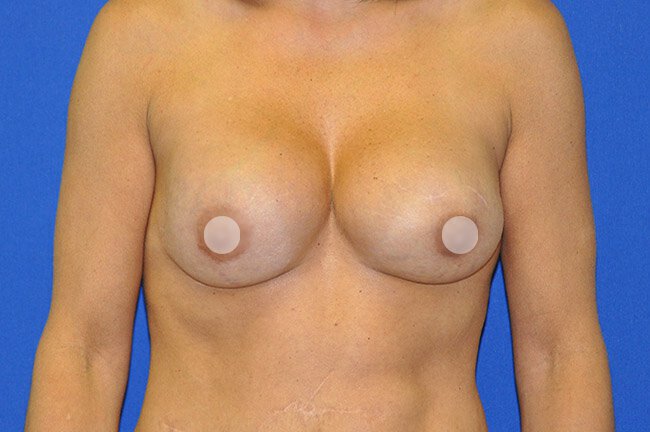
Before. Patient with capsular contracture in both breasts.
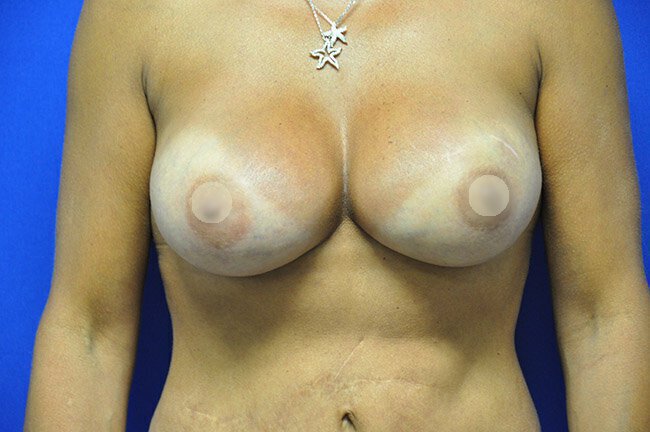
After.
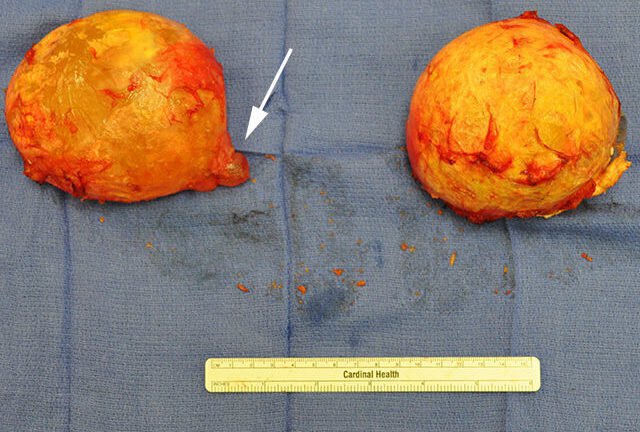
Patient had silicone implants inserted in 1979. Implants finally ruptured and a capsule of tissue formed around the implant. Arrow shows area of rupture. We took the implants out and replaced them with made in the USA cohesive implants.
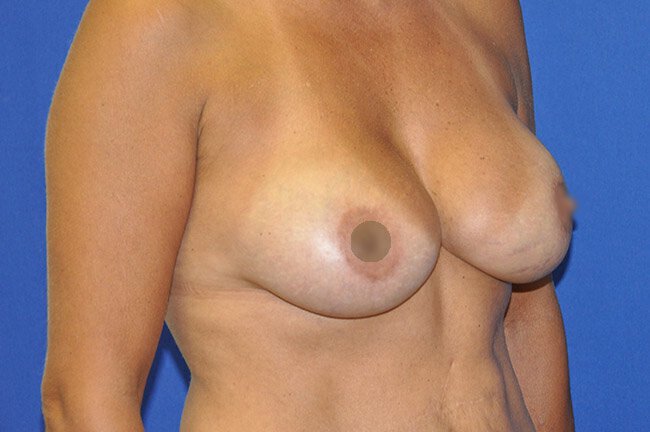
Before Breast Revision. Patient had capsular contracture of both breasts.
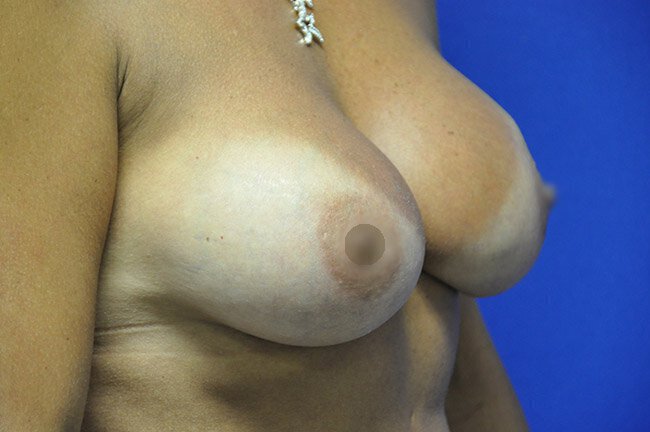
After Revisional Surgery. Patient underwent capsulectomy with breast implant replacement to correct a capsular contracture from previous breast augmentation.
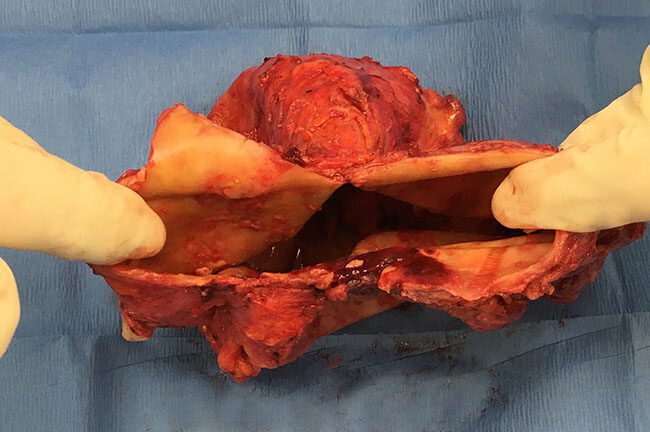
A capsule of tissue will form around a breast implant. This process is normal. However, when a capsule becomes excessively tight, firm, or mishapen, we call this a contracture, a.k.a. capsule contracture. This is a complex tissue treated medically and surgically.
This procedure involves removal of only a portion of the capsule. This is our least common procedure for treatment of contracture, but it does play a role for some patients who have a focused area of scar contracture. Typically, this type of procedure is done on patients who have not had appropriate unilateral descent of their implant. Surgery involves removing only the offending area of capsule. Postoperatively, patients are started on lymphatic massage and medical therapy. In appropriately selected patients, this treatment is very effective, but not all patients are candidates for this approach. We do NOT use surgical drains with this procedure.
This operation removes the entire capsule and all associated scar tissue with your existing implant. Once the implant and capsule are removed, a new implant is placed after the entire area is irrigated with a triple antibiotic solution. This type of procedure may also require a breast lift be done simultaneously, depending on the shape and size of the breast.
This operation uses the abnormal capsule to our advantage!! In this procedure the capsule is meticulously dissected free from the surrounding breast tissue and muscle. Once this is complete, the capsule is then collapsed down to the chest wall and oversewn to provide more projection and volume to the new implant. This is a fantastic approach to contracture, and it provides some of our best results. Unfortunately, a small 8mm surgical drain is required on each side for this procedure. The drain usually removed between days 3-5 after surgery. We commonly have clients fly in from out of town for this type of surgery, as it is highly specialized, and offered by few plastic surgeons.
There is a great deal of long term clinical data that suggests that implants placed above the muscle may have more capsular contracture than implants placed below the muscle. If you have an above the muscle implant with contracture, the treatment of choice is total capsulectomy, removal of your current implant, and placement of a new implant beneath the muscle with a sling. This procedure is our most common form of revision, as it provides a soft, natural look to your breast. Belladerm is a type of biologic mesh that revascularizes once inside your body. It essentially becomes part of the breast structure, providing a permanent internal support bra for your implant in its new position.
This is a very viable approach to treating contracture, and while most clients wish to save their augmentation, many do not want to keep their implant. Removal of the entire implant without capsulectomy can be done with local anesthesia only. In this approach, the capsule is left behind, but it will commonly soften up over time. In cases where it continues to be hardened, secondary capsulectomy can be used at a later date to reduce internal scar burden. In summary, capsular contracture is not the end of the world, and it does not necessarily require permanent removal of the implant. A summary of the different grades of contracture are provided below. Please let us know if our institution can help you on your journey back to wellness, balance, and self.
Interested in non-surgical options for your body concerns? Visit Ocean Drive MedSpa for non-surgical alternatives that can help you achieve the body and skin you've always wanted. Our expert team is trained in the latest techniques and technologies to provide you with the best possible results. Say goodbye to expensive and invasive surgeries, and hello to a fresh, new you. Visit our website to learn more and schedule a consultation today.
Visit Ocean Drive MedSpa
At Ocean Drive Plastic Surgery in Vero Beach, Dr. Alan Durkin and their team of providers deliver incredible results tailored to your needs in a relaxing and uplifting atmosphere. Learn more about the Ocean Drive difference by scheduling your one-on-one diagnostic consultation with Dr. Durkin or Dr. Chim today.